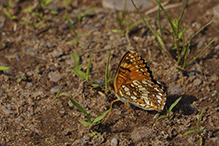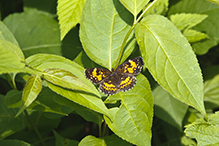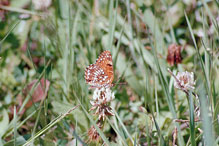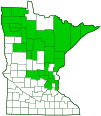Harris’ checkerspot
(Chlosyne harrisii)
Conservation • Description • Habitat • Ecology • Distribution • Taxonomy
Conservation Status |
|
|||||||
| IUCN Red List | not listed |
|||||||
| NatureServe | N3N4 - Vulnerable to Apparently Secure S4 - Apparently Secure |
|||||||
| Minnesota | not listed |
|||||||
Description |
||
Harris’ checkerspot is a medium-sized brushfoot butterfly. It has a wingspan of 1 7 ⁄16″ to 2″. The female is larger and lighter than the male. The upperside of both wings is orange with a broad black margin, a black and white fringe, and other black markings. The basal and discal areas are sometimes mostly black with a few irregular orange spots, sometimes mostly orange with irregular black spots and jagged lines. There is a broad orange crescent in the median area that is sometimes bisected by a thin, jagged, black line. There are irregular, black, submarginal patches on the forewing and a row of small, black, submarginal spots on the hindwing. At least some of the hindwing dots touch the margin. The underside of the wings are very distinctive and are the best identifying feature. The underside of the forewing is orange with a medial row of four black spots; a black apical area; a postmedian row of 5 pale orange or white spots; a submarginal band of black-rimmed pale orange or white crescent-shaped spots; an orange marginal band; and a thin black line on the outer margin. The underside of the hindwing is orange with many black-rimmed white or pale orange spots. There are several spots in the basal area; three bands of connected spots in the median area; a band of tiny postmedial spots; and an uninterrupted band of crescent-shaped submarginal spots. The marginal band is orange and there is a thin black line on the outer margin. The caterpillar is up to 1¾″ long, orange-and-black striped, and spiny. Though fierce looking, they are harmless to the touch. The first segment of the thorax is black, the second is mostly orange, the third is orange. The first eight abdominal segments each have a broad orange band and two narrow sets of alternating black and orange bands. The bands are completely interrupted at the level of the breathing pores (spiracles). The spiracles on the first through eighth abdominal segments are followed by small yellow spots. Each broad orange abdominal band has several black, branched spines (scoli). The branches of the scoli are needle-like and less than half as long as the scolus is tall. The ninth abdominal segment is mostly orange, the tenth is black. The head is black and is densely covered with long, straight, unbranched, black, hair-like structures (seta) but no scoli. Mature caterpillars are found from late May to mid-June. |
||
Size |
||
Wingspan: 1 7 ⁄16″ to 2″ |
||
Similar Species |
||
Baltimore checkerspot (Euphydryas phaeton) caterpillar is similar but has less orange on the second thoracic segment and the ninth abdominal segment. The branches of the scoli are hair-like and are nearly as long as the scolus is tall. Silvery checkerspot (Chlosyne nycteis) submarginal spots on the hindwing do not touch the margin—they are completely surrounded by orange. The underside of the hindwing is pale, not brightly colored. The submarginal band of crescent-shaped white spots on the underside of the hindwing is interrupted by a brown patch. |
||
Habitat |
||
Mostly wet, brushy meadows; also pastures, marsh edges, bog edges, forest openings, and ditches. |
||
Ecology |
||
Season |
||
One brood from early June to late July |
||
Behavior |
||
|
||
Life Cycle |
||
After mating in the spring the female chooses a large plant in a dense stand of flat-topped aster and lays a cluster of about 200 eggs on on the underside of a leaf. The host plant is often completely stripped of leaves and the caterpillars must search for another aster stem. Many caterpillars starve or are consumed by predators before finding another host. The 3rd stage instar caterpillar overwinters at the base of a host plant in a reduced metabolic state (diapause). Many larvae do not survive the winter. In the spring the caterpillar resumes feeding. Flight time is very short, beginning in early June, with peak flight time in the last three weeks of June, and ending before August. |
||
Larva Hosts |
||
Adult Food |
||
Flower nectar |
||
Distribution |
||||
|
Sources |
|||
| 7/11/2023 | ||||
Occurrence |
||||
Uncommon and local |
||||
Taxonomy |
|||
Order |
Lepidoptera (Butterflies and Moths) | ||
Superfamily |
Papilionoidea (Butterflies) | ||
Family |
Nymphalidae (brush-footed butterflies) | ||
Subfamily |
Nymphalinae (checkerspots, anglewings, peacocks, and allies) | ||
Tribe |
Melitaeini (checkerspots) | ||
| Subtribe | Chlosynina | ||
Genus |
Chlosyne (patches and allies) | ||
Synonyms |
|||
|
|||
Common Names |
|||
Harris’ checkerspot |
|||
Glossary
Diapause
A period of decreased metabolic activity and suspended development.
Scolus
A spiny, branched projection from a larval body wall, the branches terminating with a single stiff, hair-like or bristle-like tip.
Seta
A usually rigid bristle- or hair-like structure on butterflies and moths used to sense touch. Plural: setae.
Spiracle
A small opening on the surface of an insect or arachnid through which it breathes.
Visitor Photos |
|||||
Share your photo of this insect. |
|||||
| This button not working for you? Simply email us at info@MinnesotaSeasons.com. Attach one or more photos and, if you like, a caption. |
|||||
Dean Hansen |
|||||
 |
|||||
MinnesotaSeasons.com Photos |
|||||
 |
 |
||||

Slideshows |
||

Visitor Videos |
|||
Share your video of this insect. |
|||
| This button not working for you? Simply email us at info@MinnesotaSeasons.com. Attach a video, a YouTube link, or a cloud storage link. |
|||
Other Videos |
|||
| Harris' checkerspot mud puddling Meena Haribal |
|||
About
Uploaded on Jun 16, 2009 No description available. |
|||
| Harris checkerspot feeding on clover flower Meena Haribal |
|||
About
Uploaded on Jun 16, 2009 No description available. |
|||
| Harris' checkerspot mating pair Meena Haribal |
|||
About
Uploaded on Jun 16, 2009 No description available. |
|||

Visitor Sightings |
|||||
Report a sighting of this insect. |
|||||
| This button not working for you? Simply email us at info@MinnesotaSeasons.com. Be sure to include a location. |
|||||
|
|||||
MinnesotaSeasons.com Sightings |
|||||

Last Updated:
